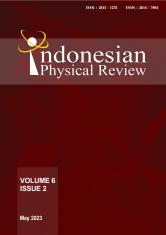DYNAMICS NOISE BEHAVIORS ON MAGNETO-OPTICAL KERR EFFECT MEASUREMENT SYSTEM
DOI:
10.29303/ipr.v6i2.231Downloads
Abstract
Nowadays, computer and data processing industry are moving to nanomagnetic devices technology. One of the common measurement systems to observe nanomagnetic device are magneto optical Kerr effect and Faraday effects. The magneto-optical Kerr effect measurement system has been fabricated and precision noise measurement configuration was observed. A light intensity, which was reflected by thin film nanomagnetic surface, was measured accompany with its noise level. The lock-in amplifier was attached to pick up hysteresis signal and low noise level. Different frequency of lock-in amplifier was carried out to observe dynamics noise level behavior. Interestingly, we found butterfly shape noise corresponding to hysteresis loop shape. Furthermore, Â noise behavior with 0.94 scaling exponent, was found with respect to lock-in amplifier frequencies suggested that measuring in low frequency became more challenging.
Keywords:
nanomagnetics magneto-optical Kerr effect butterfly noiseReferences
Z. An, F. Q. Liu, Y. Lin, and C. Liu, “The universal definition of spin current,†Sci Rep, vol. 2, 2012, doi: 10.1038/srep00388.
L. Cheng et al., “Far out-of-equilibrium spin populations trigger giant spin injection into atomically thin MoS 2,†Nature Physics, vol. 15, no. 4. Nature Publishing Group, pp. 347–351, Apr. 01, 2019. doi: 10.1038/s41567-018-0406-3.
D. Handoko, S. H. Lee, K. Min Lee, J. R. Jeong, and D. H. Kim, “Comparison of hysteresis loop area scaling behavior of Co/Pt multilayers: Discrete and continuous field sweeping,†J Magn Magn Mater, vol. 351, pp. 82–86, 2014, doi: 10.1016/j.jmmm.2013.09.053.
D. Handoko et al., “Dynamic Scaling Behavior of Nucleation and Saturation Field during Magnetization Reversal of Co/Pt Multilayers,†IEEE Trans Magn, vol. 52, no. 2, Feb. 2016, doi: 10.1109/TMAG.2015.2483581.
D. T. Quach et al., “Analysis of Magnetic Relaxation with Pre-Existing Nucleation Sites Based on the Fatuzzo-Labrune Model,†IEEE Trans Magn, vol. 51, no. 11, Nov. 2015, doi: 10.1109/TMAG.2015.2443855.
E. Milotti, “noise: a pedagogical review.†[E-book] Available: ResearchGate.
B. DrinÄić, X. Tan, and D. S. Bernstein, “Why are some hysteresis loops shaped like a butterfly?,†in Automatica, Dec. 2011, vol. 47, no. 12, pp. 2658–2664. doi: 10.1016/j.automatica.2011.08.027.
Y. Hou, D. F. Wang, and T. Itoh, “Maximizing modulation efficiency to minimize 1/f noise in magnetoresistance,†Measurement (Lond), vol. 207, Feb. 2023, doi: 10.1016/j.measurement.2022.112396.
S. Chander, S. K. Sinha, and R. Chaudhary, “Comprehensive review on electrical noise analysis of TFET structures,†Superlattices and Microstructures, vol. 161. Academic Press, Jan. 01, 2022. doi: 10.1016/j.spmi.2021.107101.
A. Rehman et al., “Nature of the 1/f noise in graphene—direct evidence for the mobility fluctuation mechanism,†Nanoscale, vol. 14, no. 19, pp. 7242–7249, Apr. 2022, doi: 10.1039/d2nr00207h.
Y. W. Windsor, A. Gerber, M. Karpovski Raymond, and B. Sackler, “Dynamics of Successive Minor Hysteresis Loops.â€
E. Z. Meilikhov and R. M. Farzetdinova, “Creeping of minor hysteresis loops in Co thin films,†J Appl Phys, vol. 112, no. 6, Sep. 2012, doi: 10.1063/1.4754560.
T. C. Fung, G. Baek, and J. Kanicki, “Low frequency noise in long channel amorphous In-Ga-Zn-O thin film transistors,†J Appl Phys, vol. 108, no. 7, Oct. 2010, doi: 10.1063/1.3490193.
C. Y. Jeong, J. I. Kim, J. H. Lee, J. G. Um, J. Jang, and H. I. Kwon, “Low-Frequency Noise Properties in Double-Gate Amorphous InGaZnO Thin-Film Transistors Fabricated by Back-Channel-Etch Method,†IEEE Electron Device Letters, vol. 36, no. 12, pp. 1332–1335, Dec. 2015, doi: 10.1109/LED.2015.2489223.
L. K. J. Vandamme, X. Li, and D. Rigaud, “1/f Noise in MOS Devices, Mobility or Number Fluctuations?,†IEEE Trans Electron Devices, vol. 41, no. 11, pp. 1936–1945, 1994, doi: 10.1109/16.333809.
License

This work is licensed under a Creative Commons Attribution-NonCommercial-ShareAlike 4.0 International License.
Authors who publish with Indonesian Physical Review Journal, agree to the following terms:
- Authors retain copyright and grant the journal right of first publication with the work simultaneously licensed under a Creative Commons Attribution-ShareAlike 4.0 International Licence (CC BY SA-4.0). This license allows authors to use all articles, data sets, graphics, and appendices in data mining applications, search engines, web sites, blogs, and other platforms by providing an appropriate reference. The journal allows the author(s) to hold the copyright without restrictions and will retain publishing rights without restrictions.
- Authors are able to enter into separate, additional contractual arrangements for the non-exclusive distribution of the journal's published version of the work (e.g., post it to an institutional repository or publish it in a book), with an acknowledgment of its initial publication in Indonesian Physical Review Journal.
- Authors are permitted and encouraged to post their work online (e.g., in institutional repositories or on their website) prior to and during the submission process, as it can lead to productive exchanges, as well as earlier and greater citation of published work (See The Effect of Open Access).





